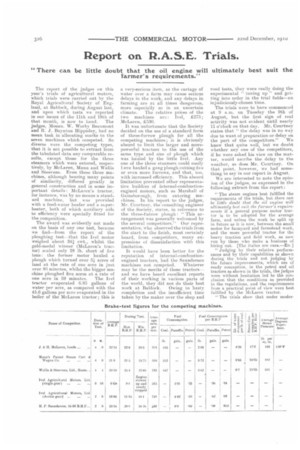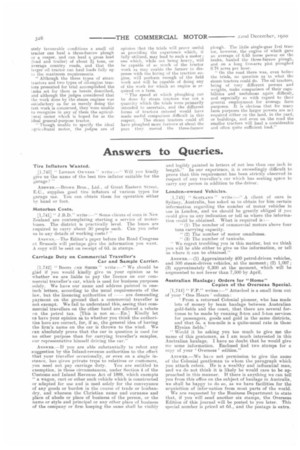Report on R.A.S.E. Trials.
Page 12

Page 14

If you've noticed an error in this article please click here to report it so we can fix it.
"There can be little doubt that the oil engine will ultimately best suit the farmer's requirements."
The report of the judges on this year's trials of agricultural motors, which trials were carried out by the Royal Agricultural Society of England, at Baldock, during August last, and upon which tests we reported in our issues of the 11th and 18th of that month, is now to hand. The judges, Messrs. W. Worby Beaumont and R. J. Bayntun Hippisley-, had no mean task in allocating marks to the seven machines which competed. So diverse were the competing types, that it is not possible to extract from the tabulated data any comparable results, except those for the three steamers which were entered, respectively, by McLaren, Mann and Wallis and Steev ens. Even these three machines, although bearing many points of similarity, differed greatly in general construction and in some important details : McLaren's tractor, for instance, was by no means a. standard machine, but was provided with a feed-water heater and a superheater, both of which auxiliary aids to efficiency were specially fitted for the competition.
The award was evidently not made on the basis of any one test, because we find—from the report of the ploughing test--that the Ivel motor weighed about 341 cwt., whilst the gold-medal winner (MeLaren's tractor) scaled only 28 lb. short of five tons ; the former motor hauled a plough which turned over 51 acres of land at the rate of one acre in just over 80 minutes, whilst the bigger machine ploughed five acres at a rate of one acre in 59 minutes. The Ivel tractor evaporated 6.85 gallons of water per acre, as compared with the 95.6 gallons per acre evaporated in the boiler of the McLaren tractor ; this is a very-serious item, as the cartage of water over a farm may cause serious delays in the work, and any delays in farming are at all times dangerous, more especially so in an uncertain
climate. The relative prices of the two machines are Ivel, £275; McLaren, £530.
It was unfortunate that the Society decided on the use of a standard form of three-furrow plough for all the competing machines; it is obviously absurd to limit the larger and morepowerful tractors to the use of the same type and size of plough which was hauled by the little Ivel. Any one of the three steamers could easily have hauled a gang plough cutting five or even more furrows, and that, toe, with increased efficiency. This absurd limitation prevented other representative builders of internal-combustionengined motors, such as Marshall of Gainsborough, from entering machines. In his report to the judges, Mr. Courtney, the consulting engineer of the Society, states, in reference to the three-furrow plough: " This arrangement was generally welcomed by the several competitors." Our representative, who observed the trials from the start to the finish, most certainly heard, from competitors, many expressions of dissatisfaction with this
It would have been better for the reputation of internal-oombustionengined tractors, had the Saunderson machines not competed. Whatever may be the merits of these tractors--and we have heard excellent reports of their working in various parts of the world, they did not do their best work at Bahlock. Owing to hasty completion and the insufficient time taken by the maker over the shop and
road tests, they were really doing the experimental "tuning up" and getting into order in the trial fields—an injudiciously-chosen time.
The trials were to have commenced at 9 a.m. on Tuesday the 9th of August, but the first sign of real activity was not evident. until nearly 11 o'clock on that day. Mr. Courtney states that " the delay was in no way due to want of preparation or delay on the part of the competitors." We know that quite well, but we doubt whether any one of the competitors, if he were asked his view on the matter, would ascribe the delay to the weather, as does Mr. Courtney. On that point, however, we had something to say in our report in August.
We are interested to note the opinion of the judges, as expressed in the following extract from the report :
"The steam engines best fulfilled the requirements of the trials, but there can be little doubt that the ail engine will ultimately best suit the farmer's requirements if a general purpose motor tractor is to be adopted for the average farm, and unless the work be split up in future as it is now, between the small motor for farmyard and farmstead work, and the more powerful tractor for the heavy traction and field work, as now run by those who make a business of hiring out. [The italics are ours.—En.] " Judging by their relative performances and by their capabilities as shown during the trials and not judging by the future improvements, which are of ready conception, in the petrol and oil tractors as shown in the trials, the judges were without hesitation led to the conclusion that the conditions as provided in the regulations, and the requirements from a practical point of view were best fulfilled by the McLaren tractor.
" The trials show that under moder ately favourable conditions a small oil tractor can haul a three-furrow plough or a reaper, and can haul a gross load (load and trailer) of about 3 tons, on average country roads, and that the larger oil tractor can haul loads fully up to the maximum requirements.
"Although the three types of steam tractors and two types of oil-engine tractors presented for trial accomplished the tasks act for them as herein described, and although the judges considered that the work done by the steam engines was satisfactory as far as merely doing the test work is concerned, they were unable to recognize in any of them the agricultural motor which is hoped for as the ideal general-purpose tractor.
" Though unable to specify the ideal agricultural motor, the judges are of opinion that the trials will prove useful as providing the experience which, if fully utilized, may load to such a motor ; one which, while not being heavy, will he capable of so much of the tractor work as may enable the farmer to dispense with the hiring of the traction engine, will perform enough of the field work and will be capable of doing any of the wink for which an engine is required on a farm. " The speed at which ploughing can be done by steam tractma was not a quantity which the trials were primarily intended to ascertain, and the different forms of tractors entered would have made useful comparison difficult in this respect. The steam tractors could all have ploughed more furrows at about the pace they moved the three-furrow plough. The little single-gear Ivel tractor, however, the engine of which gave an average of 6.65 horse power on the brake, hauled the three-furrow plough, and on a long five-acre plot ploughed 0.74 acres per hour. " On the road there was, even before the trials, no question as to what the steam tractors could do. The oil tractors, being of very different powers and weights, make comparison of their capabilities and usefulness again difficult, and especially so with regard to their general employment, for average farm purposes. It is obvious that for many farm purposes the larger powers are not required either on the land, in the yard, or buildings, and even on the road the smaller tractors will haul a considerable and often quite sufficient load."


















